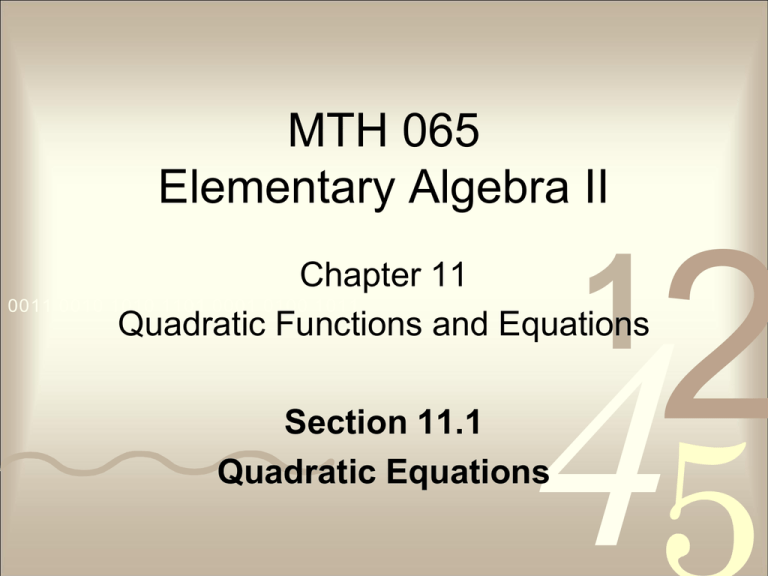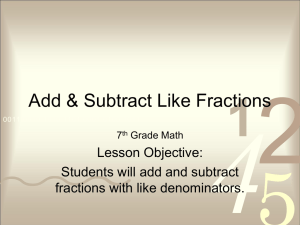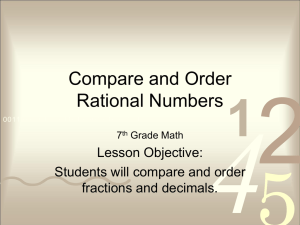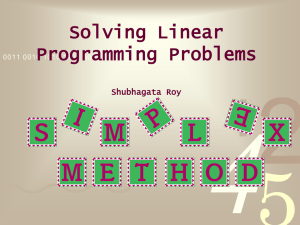Quadratic Equations
advertisement

MTH 065 Elementary Algebra II 1 Chapter 11 0011 0010 1010 1101 0001 0100 1011 Quadratic Functions and Equations 2 4 Section 11.1 Quadratic Equations Geometric Representation of Completing the Square 0011 0010 1010 1101 0001 0100 1011 x 1 x+8 Area = x(x + 8) 2 4 Geometric Representation of Completing the Square 0011 0010 1010 1101 0001 0100 1011 x Area = x2 + 8x 2 x 8x x 8 1 2 4 Geometric Representation of Completing the Square 0011 0010 1010 1101 0001 0100 1011 x Area = x2 + 8x 2 x 8x x 8 1 2 4 Geometric Representation of Completing the Square 0011 0010 1010 1101 0001 0100 1011 x Area = x2 + 8x 2 x 8x x 4 4 1 2 4 Geometric Representation of Completing the Square 0011 0010 1010 1101 0001 0100 1011 x Area = x2 + 8x 2 x 4x 4x x 4 4 1 2 4 Geometric Representation of Completing the Square 0011 0010 1010 1101 0001 0100 1011 x Area = x2 + 8x 2 x 4x 4x x 4 4 1 2 4 Geometric Representation of Completing the Square 0011 0010 1010 1101 0001 0100 1011 4 4x x 2 x 4x x 4 Area = x2 + 8x 1 2 4 Geometric Representation of Completing the Square 0011 0010 1010 1101 0001 0100 1011 4 4x ? x 2 x 4x x 4 Area = x2 + 8x + ? 1 2 4 Geometric Representation of Completing the Square 0011 0010 1010 1101 0001 0100 1011 4 4x 16 x 2 x 4x x 4 Area = x2 + 8x + 16 1 2 4 Geometric Representation of Completing the Square 0011 0010 1010 1101 0001 0100 1011 4 4x 16 x 2 x 4x x 4 Area = x2 + 8x + 16 = (x + 4)2 1 2 4 Terminology • Quadratic Equation 0011 0010 1010 1101 0001 0100 1011 Any equation equivalent to an equation with the form … ax2 + bx + c = 0 … where a, b, & c are constants and a ≠ 0. • Quadratic Function Any function equivalent to the form … f(x) = ax2 + bx + c ... where a, b, & c are constants and a ≠ 0. 1 2 4 Review Results from Chapter 6 0011 0010 1010 1101 0001 0100 1011 • Solve quadratic equations by graphing. • Put into standard form: ax2 + bx + c = 0 • Graph the function: f(x) = ax2 + bx + c • Solutions are the x-intercepts. • # of Solutions? 0, 1, or 2 1 2 4 Details of Graphs of Quadratic Functions – Section 11.6 Review Results from Chapter 6 0011 0010 1010 1101 0001 0100 1011 • Solve quadratic equations by factoring. • Put into standard form: ax2 + bx + c = 0 • Factor the quadratic: (rx + m)(sx + n) = 0 • Set each factor equal to zero and solve. • # of Solutions? 2 • 0 does not factor (not factorable no solution) • 1 factors as a perfect square (if it factors) • 2 two different factors (if it factors) 1 4 Principle of Square Roots 0011 0010 1010 1101 0001 0100 1011 For any number k, if … x k 2 … then … x k, k 1 2 4 Principle of Square Roots 0011 0010 1010 1101 0001 0100 1011 For any number k, if … x k 2 … then … x k Why? Consider the following example … x2 = 9 x2 – 9 = 0 (x – 3)(x + 3) = 0 x = 3, –3 1 2 4 Application of the Principle of Square Roots 0011 0010 1010 1101 0001 0100 1011 Solve the equation … 5 x 15 0 2 5 x 15 2 x 3 2 x 3 Note This example demonstrates how to solve a quadratic equation with no linear (bx) term. 1 2 4 Application of the Principle of Square Roots 0011 0010 1010 1101 0001 0100 1011 Solve the equation … 5 x 15 0 2 5 x 15 2 x 3 2 x 3 i 3 Note Remember to always simplify radicals. 1 2 • no perfect squares • no multiples of perfect squares • no negatives 4 Application of the Principle of Square Roots 0011 0010 1010 1101 0001 0100 1011 Solve the equations … ( x 3) 4 ( x 5) 7 x 3 2 x5 7 x 3 2 x 5 7 2 x 5, 1 2 1 2 4 Application of the Principle of Square Roots 0011 0010 1010 1101 0001 0100 1011 Solve the equation … x 8 x 16 11 2 x 8x 5 0 2 But this does not factor … ( x 4) 11 2 x4 x 4 11 1 11 2 4 Solving by “Completing the Square” 0011 0010 1010 1101 0001 0100 1011 x 6x 7 0 2 x 6 x 7 2 2 x 6 x 3 7 9 Note: This polynomial does not factor. 2 ( x 3) 2 2 x3 2 x 3 2 1 2 4 2 ax Solving + bx + c = 0 by “Completing the Square” 0011 0010 1010 1101 0001 0100 1011 • Basic Steps … 1. Get into the form: ax2 + bx = d 2. Divide through by a giving: x2 + mx = n 3. Add the square of half of m to both sides. 2 m • i.e. add 2 4. Factor the left side (a perfect square). 1 2 4 5. Solve using the Principle of Square Roots.









